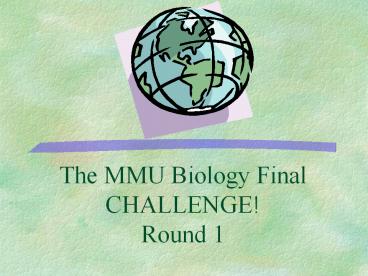The MMU Biology Final CHALLENGE! Round 1 - PowerPoint PPT Presentation
1 / 54
Title: The MMU Biology Final CHALLENGE! Round 1
1
The MMU Biology Final CHALLENGE!Round 1
2
Evolution
Human Genome
DNA Technology
Genetics Basics
Classification
100
100
100
100
100
200
200
200
200
200
300
300
300
300
300
400
400
400
400
400
500
500
500
500
500
3
Classification 100 Points
5 kingdoms of organisms
4
Classification 100 Points
Monera, Protista, Fungi, Plantae, and Animalia
5
Classification 200 Points
The difference between eubacteria and
archaebacteria.
6
Classification 200 Points
What is archaebacteria are earliest life
bacteria that live in extreme environments, while
eubacteria are commonly known as germs and can
inhabit a variety of different environments?
7
Classification 300 Points
A microscopic unicellular organism is observed to
have the following characteristics a food
gullet, a flagellum, chloroplasts, mitochondria,
and a nucleus. This organism belongs to which
kingdom?
8
Classification 300 Points
What is Protista?
9
Classification 400 Points
Linnaeus defined the biological classification
system that we still use today. It is a
hierarchical system that starts with a few
categories at the highest level, and further
subdivides them at each lower level. List the
hierarchy
10
Classification 400 Points
Kingdom
Phylum / Division
Class
Order
Family
Genus
Species
11
Classification 500 Points
Three methods of classification.
12
Classification 500 Points
- What is
- Traditional/orthodox- stresses both common
ancestry and the amount of divergence among
groups - Phentic- is a process by which taxa are clustered
together based on the number of their
similarities. - Cladistics- groups organisms based on shared
derived characters, not the overall similarity of
potential group members.
13
Basic Genetics 100 Points
The physical characteristics of an organism.
14
Basic Genetics 100 Points
What is the phenotype?
15
Basic Genetics 200 Points
Having a pair of identical alleles for a
characterisitc.
16
Basic Genetics 200 Points
What is homozygous?
17
Basic Genetics 300 Points
A situation in which a gene has more than two
alleles (ex. blood type).
18
Basic Genetics 300 Points
What is multiple alleles?
19
Basic Genetics 400 Points
An F1 rabbit that is homozygous for whiteness is
crossed with a heterozygous black rabbit. The
probability of having a white bunny.
20
Basic Genetics 400 Points
What is 50 ?
b b
B Bb- black Bb- black
b bb- white bb- white
21
Basic Genetics 500 Points
How polygenic traits and pleiotropy are opposites.
22
Basic Genetics 500 Points
- pleiotropy is when you have one gene that affects
more than one trait (ex. cystic fibrosis) - polygenic traits are when you have multiple
genes coding for one trait (ex. hair or eye color)
23
Genetic Engineering 100 Points
Using an electric voltage to separate DNA
fragments placed in a porous gel by their sizes.
24
Genetic Engineering 100 Points
What is gel electrophoresis?
25
Genetic Engineering 200 Points
An organism that contains genes from another
organism.
26
Genetic Engineering 200 Points
What is a transgenic organism?
27
Genetic Engineering 300 Points
DNA can be cut into shorter sequences by this.
28
Genetic Engineering 300 Points
What is a restriction enzyme?
29
Genetic Engineering 400 Points
What is needed to make recombinant DNA.
30
Genetic Engineering 400 Points
What is a restriction enzyme, a bacterium
plasmid, and donor DNA, and ligase?
31
Genetic Engineering 500 Points
How a PCR is made.
32
Genetic Engineering 500 Points
- DNA is heated to separate the strands
- DNA is cooled so that synthetic primers anneal to
target section - DNA is warmed for elongation of strand
- DNA polymerase makes copies of the region between
the primers
33
The Human Genome 100 Points
A condition where an individual receives three
copies of one chromosome.
34
The Human Genome 100 Points
What is a trisomy?
35
The Human Genome 200 Points
An image of all chromosomes lined up by size.
36
The Human Genome 200 Points
What is a karyotype?
37
The Human Genome 300 Points
This determines whether a person is male or
female.
38
The Human Genome 300 Points
What is the x and y sex chromosomes (number 23)?
39
The Human Genome 400 Points
Two examples of human sex-linked disorders.
40
The Human Genome 400 Points
What is color blindness, hemophilia, and muscular
dystrophy?
41
The Human Genome 500 Points
This describes the process of DNA fingerprinting.
42
The Human Genome 500 Points
- a small sample of DNA is cut with restriction
enzymes. - The fragments are separated by using
electrophoresis - fragments containing highly variable regions of
DNA are detected with a DNA probe?
43
Evolution 100 Points
Definition of a species.
44
Evolution 100 Points
What is a taxonomic group whose members can
interbreed and produce fertile offspring?
45
Evolution 200 Points
The guy who thought that organisms acquired
traits by using their bodies in new ways and then
passing those traits on to their offspring
46
Evolution 200 Points
Who is Jean-Baptiste Lamarck?
47
Evolution 300 Points
Selection where the extreme phenotypes are
eliminated.
48
Evolution 300 Points
- What is stabilizing selection?
49
Evolution 400 Points
Two types of evidence that Darwin used to support
his theory of change over time.
50
Evolution 400 Points
- The fossil record
- Geographic distribution
- Homologous structures
- Embyonic development
51
Evolution 500 Points
Conditions that are required to maintain genetic
equilibrium
52
Evolution 500 Points
- random mating
- Large population size
- No immigration or emigration
- No mutations
- No natural selection
53
It is time for round two!
54
The Daily Double































